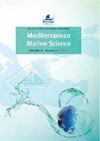Megabenthic invertebrate diversity in Mediterranean trawlable soft bottoms: a synthesis of current knowledge
IF 2.3
3区 环境科学与生态学
Q1 MARINE & FRESHWATER BIOLOGY
引用次数: 3
Abstract
Mediterranean bottom trawling is generally characterised by a highly diversified mixed catch, composed of fish, cephalopods,crustaceans, and other megabenthic invertebrates. Although management of Mediterranean trawling requires a multispecies approach on a community basis, this does not seem to be the case in the relevant literature. Herein, we present an extensive review ofthe existing knowledge on megabenthic invertebrate communities, focusing on the trawlable bottoms. A total of 207 publicationsfrom 1930 to the early 2021 was collected and classified into seven research areas. Research effort on soft bottom megabenthicinvertebrates of trawlable grounds was higher for the Western Mediterranean and the depth zone of 50-200 m. Overall, 1,797 taxawere reported belonging to different taxonomic groups, the most diverse of which were Mollusca, Crustacea, Polychaeta, andPorifera. Among the reported taxa, 43 species are alien to the Mediterranean Sea, and 42 are included in the lists of threatened/ endangered and protected species under the Barcelona and Bern Conventions. The Western Mediterranean and the Aegean Sea werethe ecoregions with the highest number of megabenthic invertebrate species reported from trawlable grounds. All Mediterraneanecoregions were grouped according to their megabenthic fauna at a similarity level of 27%. The present work compiles the knownscattered information, highlights knowledge gaps, and underlines the need for time series data on the megabenthic communitiesof the Mediterranean fishing grounds.地中海可拖网软底质中的大型底栖无脊椎动物多样性:当前知识的综合
地中海底拖网捕鱼的特点通常是高度多样化的混合渔获物,包括鱼类、头足类、甲壳类动物和其他大型底栖无脊椎动物。尽管地中海拖网捕鱼的管理需要在社区基础上采取多物种方法,但相关文献中似乎并非如此。在此,我们对大型底栖无脊椎动物群落的现有知识进行了广泛的综述,重点是拖网海底。从1930年到2021年初,共收集了207篇出版物,并将其分为七个研究领域。在地中海西部和50-200米的深度区域,对可拖网捕鱼的软底巨型底栖无脊椎动物的研究力度更大。总的来说,据报道,1797种红豆杉属于不同的分类群,其中最多样的是软体动物、甲壳动物、多毛目和多孔动物。在报告的分类群中,43种是地中海外来物种,42种被列入《巴塞罗那公约》和《伯尔尼公约》的受威胁/濒危物种和受保护物种名单。据报道,西地中海和爱琴海是拖网渔场中大型底栖无脊椎动物数量最多的生态区。所有地中海珊瑚区都根据其大型底栖动物群进行了分组,相似性水平为27%。本工作汇编了已知的模式信息,强调了知识差距,并强调了对地中海渔场大型底栖生物群落时间序列数据的必要性。
本文章由计算机程序翻译,如有差异,请以英文原文为准。
求助全文
约1分钟内获得全文
求助全文
来源期刊

Mediterranean Marine Science
MARINE & FRESHWATER BIOLOGY-
CiteScore
5.20
自引率
17.90%
发文量
34
审稿时长
>12 weeks
期刊介绍:
The journal Mediterranean Marine Science (MMS), published by the Hellenic Centre for Marine Research (HCMR), issues three volumes annually. The journal welcomes original research articles, short communications, New Mediterranean Biodiversity records, extended reviews, comments, and Theme sections in all fields of Oceanography, Marine Biology, Marine Conservation, Fisheries and Aquaculture in the Mediterranean area and the adjacent regions. All content is peer reviewed.
 求助内容:
求助内容: 应助结果提醒方式:
应助结果提醒方式:


